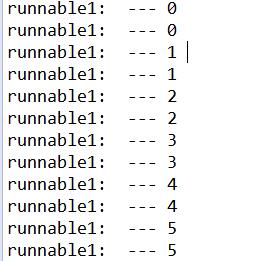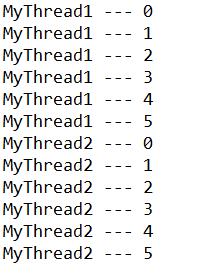Java中 Thread 与 Runnable 的区别
2023-03-15 13:52:39
michael007js
152
定义一个线程子类,并继承Thread类。 定义一个runnable子类,实现runnable接口,并将该用runnable子类传递给一个Thread类对象。 上述使用runnable接口定义多线程的好处 在java中不允许多继承的存在,若想简介使用多继承可以利用接口来实现
若想定义一个已实现某个抽象的父类的线程时,在不使用接口时,无法继续继承Thread类,那么问题就出现了,这也就是使用runnable的好处之所在。
使用runnable接口和继承Thread类的区别
利用同一个runnable子类创建线程
public class Test {
public static void main(String[] args) {
Test test = new Test();
MyRunnable runnable1 = test.new MyRunnable("runnable1: ");
Thread thread1 = new Thread(runnable1);
Thread thread2 = new Thread(runnable1);
thread1.start();
thread2.start();
}
class MyRunnable implements Runnable {
private String name;
public MyRunnable(String name) {
this.name = name;
}
@Override
public void run() {
for (int i = 0; i < 6; i++) {
System.out.println(name+" --- "+i+" ");
}
}
}
}
运行结果:
定义不同runnable子类创建线程
public class Test1 {
public static void main(String[] args) {
Test1 test = new Test1();
MyRunnable runnable1 = test.new MyRunnable("runnable1: ");
MyRunnable runnable2 = test.new MyRunnable("runnable2: ");
Thread thread1 = new Thread(runnable1);
Thread thread2 = new Thread(runnable2);
thread1.start();
thread2.start();
}
class MyRunnable implements Runnable {
private String name;
public MyRunnable(String name) {
this.name = name;
}
@Override
public void run() {
for (int i = 0; i < 6; i++) {
System.out.println(name+" --- "+i+" ");
}
}
}
}
运行结果:
通过thread子类创建线程
public class Test2 {
public static void main(String[] args) {
Test2 test = new Test2();
MyThread thread1 = test.new MyThread("MyThread1");
MyThread thread2 = test.new MyThread("MyThread2");
thread1.start();
thread2.start();
}
class MyThread extends Thread {
private String name;
public MyThread(String name) {
this.name = name;
}
@Override
public void run() {
for (int i = 0; i < 6; i++) {
System.out.println(name+" --- "+i+" ");
}
}
}
}
运行结果:
通过上述代码运行结果可以看出 通过是用runnable接口创建线程时,多个线程直接会共享同一资源,如thread1和thread2都是打印i的值,但每次打印的结果一样,即重复打印。这属于并发,还未涉及到这方面知识的学习,以后研究下 当然runnable也可以实现非并发 通过thread子类处理实际上是创建两个线程去执行run方法的** 直接new一个runnable子类对象,然后调用run方法的问题: 在java中,只有Thread代表一个线程,也就是说只有new 一个Thread或其子类才能创建一个线程。 runnable在使用过程中只表示一个普通的接口而已,跟创建线程无关联 线程池的使用原理其实也就是创建一个接受runnable子类的集合,然后不断冲集合中取出runnable子类,交给线程调用其run()方法,若集合为空则线程等待。 它实际上是上一节中讲的 内部类或者说匿名内部类


